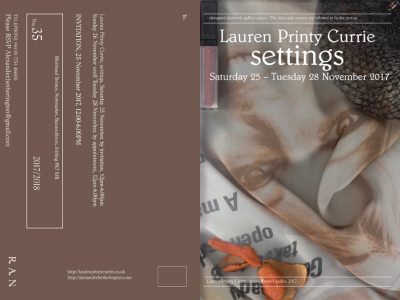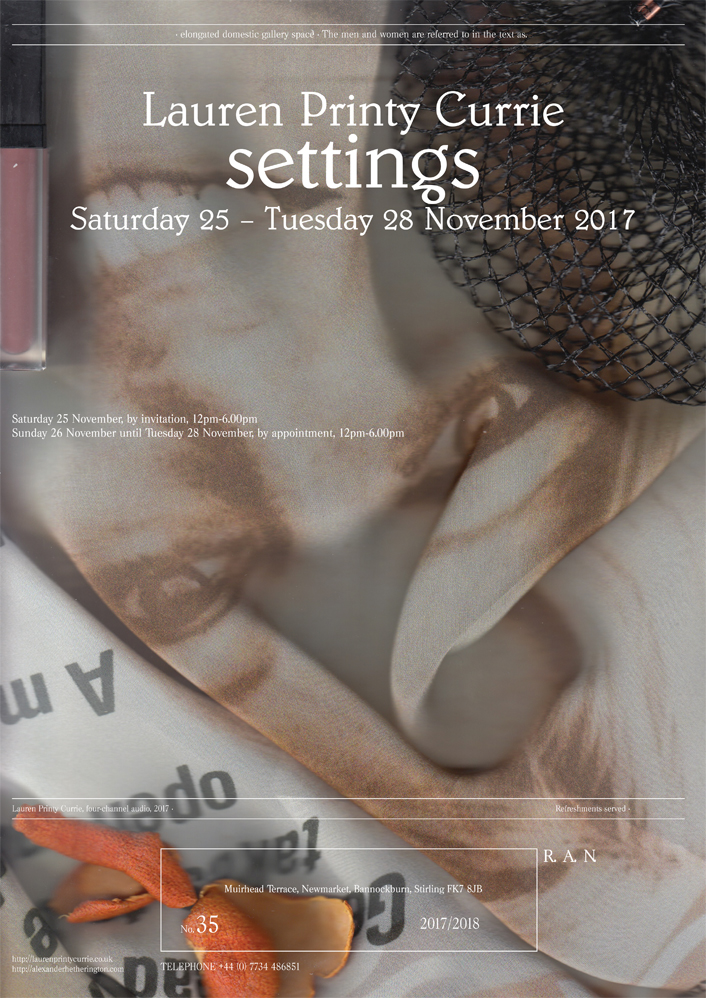settings, Lauren Printy Currie
settings, Lauren Printy Currie, four-channel audio, 2017, Saturday 25 – Tuesday 28 November 2017
I now get to see to see how the summer month light changes to winter month light. And I can read the weather by the sound the tyres make on the road outside. The ceramic-tiled corridor forms a wind tunnel: inhales at night, sighs in the early morning. A fox stayed overnight. Slugs come to die, leave trails which evaporate, the carcass drying out. The tunnel’s glassy spectrum is the colourways for the posters; LPC is umber, HM is blue, RT is greying white, AG is hazard yellow, CS is coal. I am thinking about the debris in the flat when Lauren first came here to talk about the work: stacks of greyscale and colour print, orange towels, sharp yellow notepaper, even sharper pencils, cardboard boxes, road, grass and human powder. I think of the flat since then as an instrument and a subject. Collaging in. Searching the flat and the building’s past through previous occupants’ post, archive photography from the library, finding the fireplace design in a fat elongated catalogue of the Carron Ironworks models from the late 1920s and 30s, rendered as a unique diagram in watercolour at the archives at Falkirk’s Callendar House, with rooms adorned in gold leaf and far-too-large chandeliers. A previous owner kept birds, a parrot and rare mynah bird and had a drinks trolley for very strong cocktails for weekend parties. I wonder which of these voices is real. His bedroom was bright red, the rest of the flat in lavender, plum and brown. There was genuine anger here and pure love. The building stood apart at one point, pointing to coal mines in Plean and California. And to a mental hospital that was torn down last year. People’s livelihoods here dependent on excavating the mineral in the ground or the slow cavities of the faltering of the mind. The photograph that showed the house after it was built in the 1920s explained what it was like to be lonely here. Looking at it now it explains what an invisible montage is.
Hoarseness as a thing that is uncanny/eerie, not being in a space anymore, something is missing (a sound/a presence) and replaced with something more diffuse, strange. How do I write ‘hoarseness’? How do I write ‘distance’? How do I write ‘proximity’? Subtitling. What does hoarse sound like within the written word? Trying to refine the thing that creates the loss… Mimicry, trying to find ways to connect/to be in someone else. ‘A position’. The underlying loneliness we all feel, the loneliness in the desire to be understood, an endless and real struggle. Translation. Explaining. I want to explain the position, what is from a place rather than about a person or a thing or a time. Parrot as avatar/pirate-symbol/people-pe


